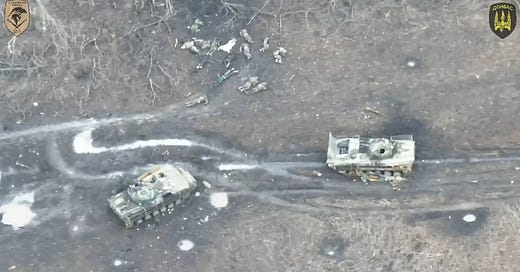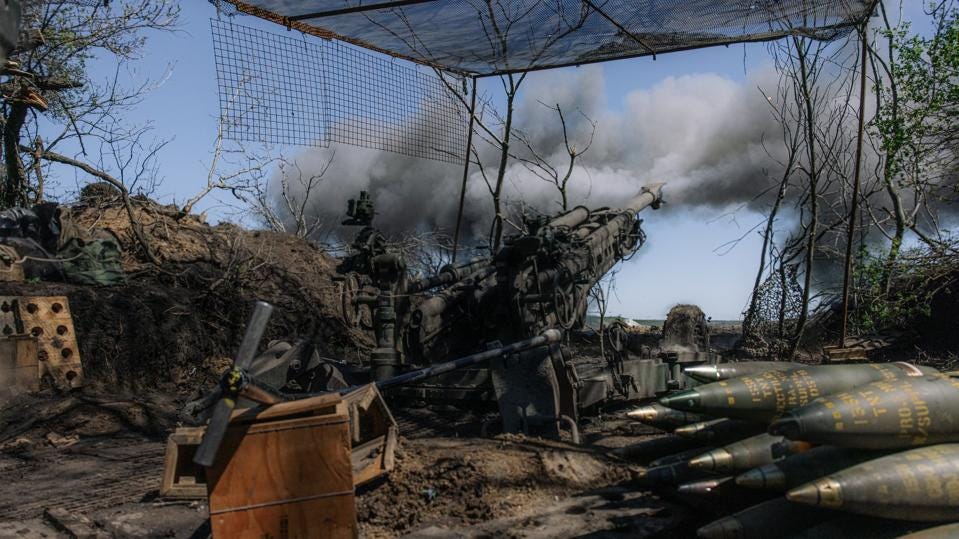Outgunned and Outbombed, Ukrainian Troops Still Manage to Defeat Entire Russian Tank Battalions
More Russian assaults are ending in devastation and retreat
Three days after sending a whole battalion with dozens of tanks and fighting vehicles on a one-way mission to assault an entrenched force of missile-armed Ukrainian paratroopers, the Russian army tried again to deploy a large mechanized force—a dozen T-72 tanks plus BMP and BTR fighting vehicles—against dug-in Ukrainians.
The Tuesday assault, just east of Terny in eastern Ukraine, ended the same way the Saturday assault did: with most of the Russian vehicles in flames, and the surviving crews and passengers fleeing the way they came.
The failed Russian attack is just the latest in a long series of them, and it begs the question: what are Russian commanders doing?
It’s clear what they’re not doing. They’re not following their own new doctrine. And there are tantalizing hints as to why. In brief, Russian forces apparently aren’t as flush with artillery, bombs, drones and functional jammers as they might seem to be.
When Ukraine’s summer offensive ground to a halt around August or September along the three sectors—two in south, one the east—where the Ukrainians managed, at high cost, to gain some ground, Russia seized the initiative in its now three-year wider war on Ukraine.
Russia’s winter-spring offensive initially focused on Avdiivka, a Ukrainian stronghold just northwest of Donetsk in eastern Ukraine. In five months of bloody fighting, the Russians finally forced the city’s Ukrainian garrison to retreat. In the weeks that followed, the Russians continued attacking west of Avdiivka and also in other sectors in the east and south.
These attacks—from the Avdiivka campaign to the smaller operations that followed—followed the same basic pattern, according to Ukrainian analysis group Frontelligence Insight. “Preceding the assault, Russians deploy KAB guided air-dropped bombs against Ukrainian positions and proceed with artillery preparatory shelling.”
“A small number of Russian forces, ranging from a squad to a company in size, advances either on foot or mounted atop vehicles,” the analysis group continued. “During the move, Russians try to decrease risks associated with [first-person-view] drones, equipping vehicles with electronic-warfare systems.”
“Upon encountering initial contact or reaching approximately 50 to 150 [yards] from Ukrainian positions, attacking units swiftly dismount and proceed to assault, supported by FPV drones and tank fire, if available.”
Rapid, back-to-back-to-back assaults by small mechanized units—modern-day “banzai charges,” if you will—worked at first. The Russians extended their gains from Avdiivka to the villages to the west, and also advanced around the ruins of Bakhmut, 50 miles north of Donetsk.
But note the critical role of air and artillery superiority in the Russians’ small-unit methods. As Frontelligence stressed, Russian attacks in the current offensive require both extensive support from army artillery and air force Sukhoi fighter-bombers lobbing powerful KAB glide-bombs, as well as closer support from FPV drones plus—and this is critical—the suppression of Ukrainian forces’ own FPVs.
Where the KAB bombings are inadequate, the supporting FPVs are too few or ineffective owing to Ukrainian jamming and the Ukrainians’ succeed in launching their own FPVs, there’s a good chance a Russian assault will fail.
And scaling up the assaults—from platoon-size actions to battalion-size ones—hasn’t helped. Ukrainian brigades, well-supplied by workshops that build 100,000 FPVs a month, simply have launched more drones. Add mines, anti-tank missiles and precision artillery fire to the defensive fires, and the under-supported Russians don’t stand much of a chance.
So a company-size assault with tanks and BMPs, possibly by the Russian army’s 144th Motor Rifle Division, failed outside Terny in mid-February. Six weeks later on Saturday, a battalion from the 6th Tank Regiment with 48 tanks and BMPs got wrecked outside of Tonen’ke just west of Avdiivka. Three days after that, the 144th Division, it seems, tried again and also got dismantled.
Infantry assault groups assigned to the Russian army’s 114th Motor Rifle Brigade, fighting just south of Terny, got badly bloodied in repeated mid-March assaults on positions apparently held by the Ukrainian army’s elite 3rd Assault Brigade. The survivors recorded a video pleading for assistance—and also for mercy from uncaring superior officers. “We assault without fire and artillery support,” one survivor says in the video, translated by @wartranslated.
It’s apparent that Russia’s ground assaults don’t always enjoy the support they require for a reasonable chance of success. While the Ukrainian armed forces’ artillery shortage and the relative rarity of their glide-bombing sorties are well-known, the Russians’ own shortages are less widely-reported.
Yes, Russian batteries lately have been firing five times as many shells as Ukrainian batteries have been firing. Yes, the Russian air force lobs as many as 100 KABs a day all along the 600-mile front line of the wider war. Yes, Russian industry produces tens of thousands of FPV drones a month—and also churns out small radio-jammers that should, in theory, ground Ukraine’s FPVs.
But much of the Russian artillery fire is badly aimed and thus wasted. A hundred KABs isn’t enough KABs to prepare the battlefield ahead of every Russian attack. Russia’s FPV drones are vulnerable to Ukrainian jamming. And Russia’s own jammers are notoriously unreliable.
And equally alarmingly for the Russians, a heroic effort by the Czech Republic and some of Ukraine’s other allies to buy and ship to Ukraine hundreds of thousands of artillery shells is beginning to shrink the artillery gap.
“Recent reports indicate an improvement in the ammo situation, leading to a temporary relief,” Frontelligence reported. “This improvement has enabled Ukraine to prevent the loss of important defensive positions in the east and slow down further Russian advances.”
If Ukrainian troops can defeat battalion-size Russian tank assaults while outgunned and under aerial bombardment, imagine what they could do while, say, firing as many shells as the Russians fire.
That parity isn’t impossible. If Mike Johnson, the Russia-friendly speaker of the U.S. House of Representatives, honors his word and finally brings further U.S. aid to Ukraine to a vote in April following a six-month blockade by far-right Republican lawmakers, the United States might soon ship enough artillery ammunition to Ukraine to make the elimination of entire Russian battalions a routine affair.
Read more:
Ukraine Might Be Getting $34 Billion In American Weapons—And Soon
Six months after initially blocking a vote on further U.S. aid to Ukraine, the Russia-friendly speaker of the U.S. House of Representatives, Louisiana religious hardliner Mike Johnson, finally has relented to overwhelming pressure from the majority of…






